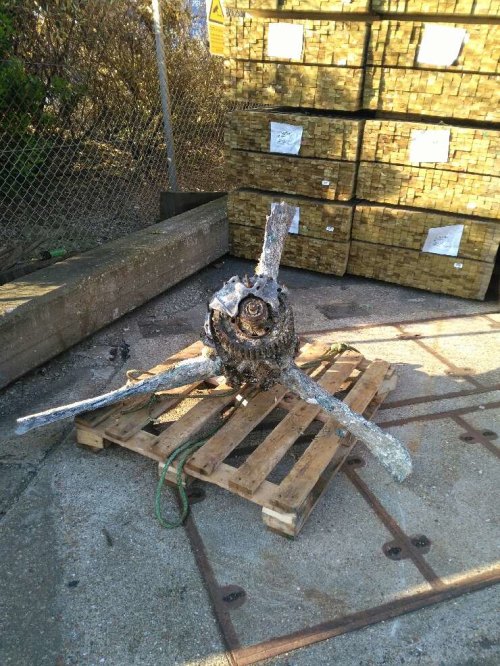
Image use policy
Our images can be used under a CC BY attribution licence (unless stated otherwise).
AIRCRAFT COMPONENT
Unique ID: MAS-F100172
Workflow
status: Published ![]()
Rolls Royce Merlin 45 gear unit, serial number GU 69 677, with a truncated, heavily damaged and corroded, three bladed propeller. All three propeller blades have survived despite heavy corrosion, though the end of one is missing. The wiring in the propeller cam shaft is visible since the outer dome casing has partially disintegrated. The Merlin 45 engine was used in the Mk. V Supermarine Spitfire fighters, in Reconnaissance Spitfires (PR Mk. IG & P MK. IV), and early versions of the naval version the Supermarine Seafire Mk. IB and Mk. IIC). The Merlin 45 saw active service from early 1941 as squadrons were equipped with the new Mk. V Spitfires.
Consultation with Boscombe Down Aviation Collection has suggested that this aircraft likely landed on the water, rather than crashed directly, as the damage to the propellor blades is minimal. Given that the nose of an aircraft is most likely where the initial impact of a crash would occur this would appear a more than probable conclusion. Additionally, following cleaning and initial preservation steps, it was noted that there are two circular scollops in the edge of one of the propellor blades (see image 13 of 13). Boscombe Down Aviation Collection suggest that these are of a diametre closely matching that of cannon shells that may have been fired at the Spitfire from a German aircraft such as a Messerschmitt BF 109E. This evidence suggests that the aircraft, to which this Gear unit belonged, was in combat shortly before its loss. The damaged sustained likely caused the engine to fail, causing the pilot to belly land the aircraft on the sea. It is to be hoped that he successfully exited the aircraft and was rescued following these events. Efforts to identify the exact aircraft from which this gear unit originated are being contiued by Boscombe Down AC.
Notes:
The Mk. V Spitfires were initially developed in late 1940 as a high altitude interceptor and were essentially remodelled Mk I & Mk II spitfires with a new engine, later Mk V's were purpose built airframes.
The PR Mk. IG (Armed) & P MK. IV (Unarmed) Spitfires were variants created to fulfil the role of photo- reconnaissance of enemy held territory. On some variants the planes had all their armament removed and often replaced with additional fuel tanks to increase their operational range. Their speed, small size and high operational ceiling allowed them to either remain undetected or avoid enemy aircraft. This role had previously been performed by light bombers, such as the Bristol Blenheim, or purpose built reconnaissance aircraft, such as the Westland Lysander. They are both relatively slow aircraft and the Lysander had no armament what so ever, as a result early war losses were high and an alternative solution was sought.
The Seafire was a naval version of the Spitfire, adapted for use on aircraft carriers, the first batch of which came into service in late 1941. The earlier variants being used for training to acquaint Fleet Air Arm pilots with the Spitfire air frame and using it on aircraft carriers.
Class:
vehicle
Sub class: aircraft engine
Subsequent actions
Current location of find: With Boscombe Down Aviation Collection
Wreck details
Droit number: 059/18
Chronology
Broad period: MODERN
Period from: MODERN
Period to: MODERN
Dimensions and weight
Quantity: 1
Discovery dates
Date(s) of discovery: Friday 27th April 2018
Personal details
Found by: This information is restricted for your login.
Recorded by: P T
Other reference numbers
Droit ID: 059/18
Materials and construction
Primary material: Steel
Secondary material: Other
Completeness: Incomplete
Spatial metadata
References cited
No references cited so far.
Similar objects

Find number: MAS-F100111
Object type: AIRCRAFT COMPONENT
Broadperiod: MODERN
Aluminium aircraft section, heavily corroded and damaged. No identifying marks or plates visible, though two cross member plate remnants prese…
Workflow: Published![]()

Find number: MAS-O100169
Object type: KNIFE
Broadperiod: POST MEDIEVAL
Double edged blade covered with concretions, around 25 mm wide and 280 mm long. Displays iron oxidation, and the item has not been preserved w…
Workflow: Published![]()

Find number: MAS-F100109
Object type: BOAT
Broadperiod: MODERN
This find is an unidentified curved aluminium sheet that measures approximately 0.94 m by 0.24 m and has a thickness of 5 mm. The sheet displa…
Workflow: Published![]()














